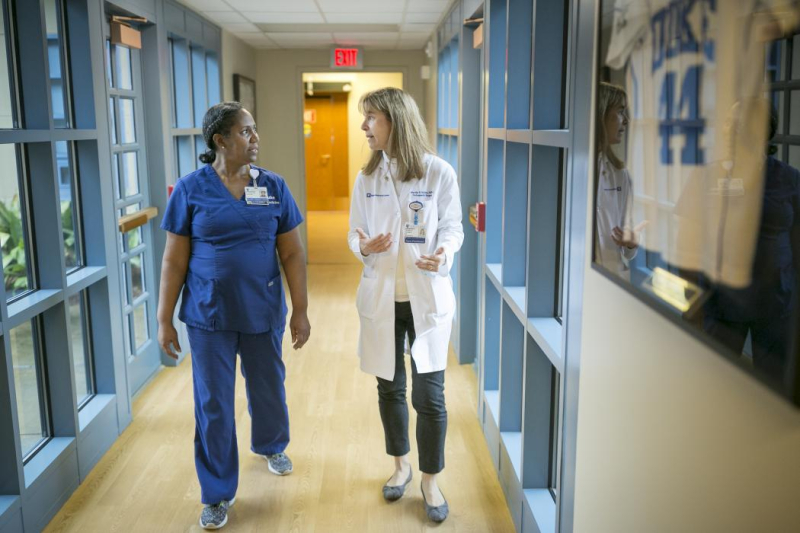
When Sara Battles took a job in a clinical research unit at Duke three years ago, she didn’t know that a massive experiment in remaking clinical research operations was beginning.
But having been in the field for eight years already, she did know that evolution was overdue.
“The clinical research world is changing,” she says. “When I started, you got thrown into whatever position was available and learned on the job.”
Cameron Howes, an Assistant Research Practice Manager, has spent her entire 12 year career at Duke, first in Orthopaedics and now in Psychiatry. For most of that time, being clinical research staff meant that her workload was “based completely on what Principal Investigators asked for and what funding they had.”
Battles and Howes are two of more than 800 clinical research professionals at Duke. For years, their career paths have traveled an irregular, sometimes even chaotic landscape of inventive job titles and blurrily defined roles.
But now, that landscape has completely changed.
Clinical research itself has changed a lot in the last twenty years—with evolutions in technology, regulations, and methods making the field more complex than ever. Naturally, this meant that the demands on the clinical research workforce changed, and people have been asked to take on increasingly diverse and sophisticated tasks.
Clinical research operations as a profession had not kept pace with these changes. As new responsibilities emerged—recruiting research participants through social media, for example—existing jobs had to be re-shaped on the fly.
“You could be asked to do things you didn’t have the position for,” says Howes. “There was a lot of variance in what one person was being asked to do and what another person at the same level was being asked to do.”
The result was a work environment at large medical research institutions like Duke that was frustrating, unfair, and inefficient in the eyes of workers and leadership alike.
Four years ago, Duke set out to solve this problem through a sweeping modernization of the clinical research landscape. Now, that effort has been fully implemented and is bearing fruit. Employees have consistent job classifications and responsibilities, as well as a clear path to advancement. The university is projected to save millions in costs through the ability to retain outstanding employees and operate more efficiently.
“Duke is now at the forefront of innovation not just in research itself, but in the way our research workforce is organized. This has created systemic efficiencies that improve the quality of clinical research,” says Mary Klotman, MD, Dean of the Duke University School of Medicine.
“The clinical research profession has been standardized across the institution,” adds Denise Snyder, Associate Dean for Clinical Research in the Duke School of Medicine. “This reduces organizational turbulence and creates opportunities for staff to grow their careers in a transparent, competency-based system.”
Building a ladder
This transformation was the result of a wide-ranging project initiated by Duke staff and made possible by collaboration with Human Resources, the support of faculty and leadership, and funding from Duke’s NIH Clinical and Translational Science Award.
It was a unique, grassroots effort in which a task force made up of staff with expertise in clinical research formed to study the problem and recommend a solution. They ultimately devised a career ladder that allows clinical research professionals to get training and demonstrate their competency in a variety of areas. They accrue points through a variety of activities, and when they accumulate enough points, they become eligible for promotion to a higher tier.
In stark contrast with the previous environment, where there were more than 80 job titles, there are now only 12 distinct job titles among the clinical research staff.
“The partnership with Human Resources was critical to our success,” says Ebony Boulware, MD, PhD, Director of the Duke Clinical and Translation Science Institute. “Today, HR managers have completely bought in and see the benefits in their own workload. We hope this leads to higher quality research and improved access to clinical research studies.”
For the employees, it has created clarity.
“I didn’t even know what level I was when I started the advancement process,” says Battles. “It helps me know where I stand professionally. I’ve had a lot more opportunities to be visible in the department, and it gives you the tools to advocate for yourself.”
Howes adds, “It was really rewarding to go out for these assessments and realize, ‘Hey, I do have these qualifications.’ It was affirming.”
Changing the landscape nationwide
The ripples of this innovation are spreading far beyond Duke’s walls. Nearly every large medical research institution faces similar problems—a confusing environment that leads to high staff turnover and job-hopping based on department funds.
“Staff turnover and training new employees is one of the largest expenses in clinical research,” says Snyder. “It costs around $25,000 per employee.”
Unsurprisingly, Duke’s new model is attracting interest nationwide. It is already being implemented at Johns Hopkins University and the University of Alabama, Birmingham, and more than a dozen other institutions have reached out to learn more.
Duke has received national recognition for its work, including the Innovation in Workforce Development Award from the Association of Clinical Research Professionals and the Rod Rose Award from the Journal of Research Administration.
The goal remains creating a finely-tuned clinical research infrastructure to support investigators.
“Researchers come to Duke in part because they know they will be supported by an outstanding clinical research team,” says Adrian Hernandez, MD, Vice Dean for Clinical Research at the Duke University School of Medicine. “This new framework is intended to raise the bar on the clinical research profession, and help people find ways to attain that bar.”
The team has published their framework in the Journal of Research Administration, and additional publications are underway.
This work received support from Duke's Clinical and Translational Science Award, grant number UL1TR002553, from the National Center for Advancing Translational Sciences (NCATS) at the National Institutes of Health.